Improve survival of young piglets and increase weaning weights with live yeast probiotic
Published: March 22, 2023
By: Juan Alberto Escoda, R&D Cincaporc • Wouter de Bruin, Western Europe Manager Swine, Phileo by Lesaffre • Laia Batet Puig, Swine Technical & Sales responsible Phileo Iberia • Roser Bobet, Veterinary Student – Universitat de Lleida.
Summary
Gestation and lactation are high demanding phases for sows, in which they require the right set of nutrients to retain body condition and produce milk. Live yeast supplementation during these phases both benefit the sows and their offspring, as confirmed by new field data from a large Spanish swine integrator.
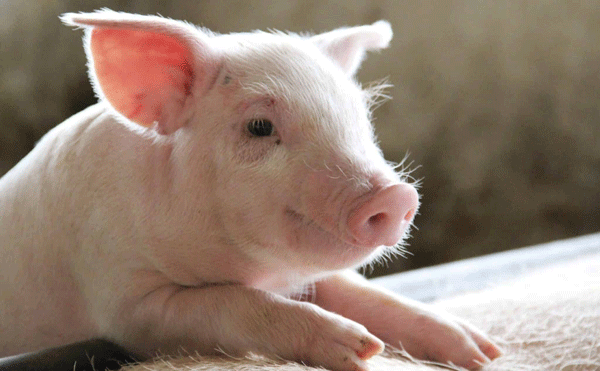
Having more piglets at birth is important, and it is even more crucial to keep them alive and healthy until weaning. The challenge with hyperprolific sows is that they produce high number of piglets with a large variety of weaning weights. It is particularly those piglets with lower body weights that require attention around weaning. Quality colostrum ensures proper immunity and stimulating feed intake levels are some of the key elements to give these piglets a boost, right from the start. But big wins can be made also with a healthy sow and focus on what she eats during the gestation and lactation. This is important as the nutritional needs vary during the different phases of a sow production cycle. During gestation, the sow needs enough energy and protein to support the growth of the mammary glands as well as the foetus. Furthermore, proper feeding management ensures sufficient production of high-quality colostrum and milk during lactation and helps to maintain body condition of sows.
Benefits of probiotic yeast
Certain yeast-based additives have demonstrated to benefit the health and performance of gestating and lactating sows and the carry-over effects to her offspring. Probiotic yeast Actisaf® Sc 47 is a live yeast (LY) and supports the development of the intestinal microflora of pigs, including sows.
This is particularly important during the end of gestation and during lactation, times when sows change from low concentrated gestation diets to highly concentrated lactation diets. The fibre rich diet as supplemented during gestation is usually replaced by an energy and protein dense diet at about 5 to 7 days before parturition. This sudden switch in diet requires adaptation of the sow’s microbiome. Supplementation of probiotic yeast Sc47 helps with this transition resulting in less constipation around farrowing. At the same time, a healthy microbiome leads to higher production volatile fatty acids (VFA’s) in the hindgut. This helps to maintain body condition of the sow and supports higher milk production.
Moreover, probiotic yeast Sc47 improves the transfer of immune globulins (IgG and IgA) (Jang et al,. 2013; Zanello et al., 2013) from sows to piglets through colostrum, and it improves nutritional quality of sows’ milk (figure 1). This helps to enhance piglets’ health and performance until weaning. Particularly at this time, now zinc oxide is banned and the use of antibiotics is constantly under pressure, weaning weights have become even more crucial.
Figure 1. Supplementation of live yeast (LY) Sc47 to sows improves the immune transfer from sows to piglets.
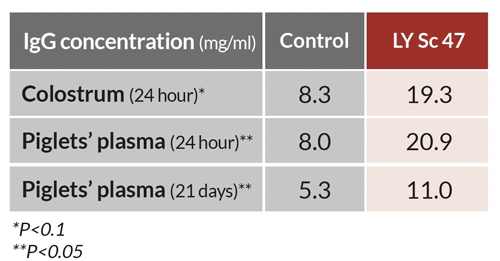
To validate the efficacy and benefits of live yeast in gestating and lactating sows with probiotic yeast Sc47 under Spanish field conditions, a study was carried out on a commercial farm (Cincaporc). Parameters measured were related to the zootechnical performance of the sows and their offspring until weaning. In this study, 96 Danbred sows with parity between 2-6 were selected and given either a standard commercial feed program from Cincaporc diet (n=50) or the same program supplemented with probiotic yeast Sc47 (n=46).
- From day 0-108 of gestation, both the control group (CON) and the supplemented group (LY) received the standard commercial gestation diet. (figure 2)
- From day 87 in gestation, the LY-group received 3 grams of probiotic yeast Sc47 (1×1010 UFC/g) per sow per day equal to 1.0 kg/tonne of complete feed considering an average feed intake of 3kg/sow/day (top dressing, using an automated dosing system connected to the feeding station). The CON-group did not receive this top dressing
- From one week before parturition until weaning, the LY-group received 6 grams of probiotic yeast Sc47 per sow per day (manual top dressing), equal to 1.0kg/tonne of feed considering an average feed intake of 6kg/sow/day during between 7 days before parturition until weaning.
All litters within each of the two trial groups were homogenized within 24 hours after birth to 15 piglets per sow. Piglets were weighted at birth and at 20 days of age.
Figure 2. Sows were split in two groups receiving all the same commercial diets. Only the LY-group received probiotic yeast Sc47 during the second half of gestation and lactation.
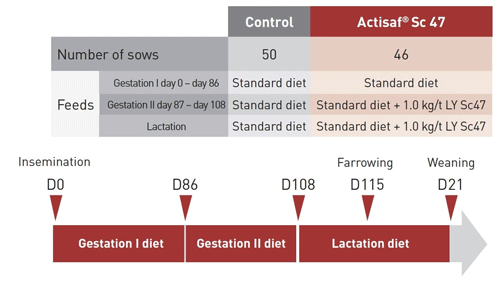
Yeast-based postbiotics have the ability to strengthen the immune response of tilapia and its survival when challenged with the most detrimental pathogens, such as A. hydrophila and S. agalactiae. A trial by Phileo demonstrated that supplementation of this yeast probiotic in feeds significantly improves the innate immune response of tilapia juveniles. This was highlighted by the activation of lysozyme (an antimicrobial enzyme) in the gut mucus and by the increase of the antibody levels (IgM) in the plasma. This enhancement in immunity conferred fish a higher chance of survival when challenged with A. hydrophila (Figure 2; internal trial data conducted at ITBOCA, Vera Cruz, Mexico).
Similar performances were also observed with S. agalactiae challenges, confirming the potential of Safmannan for preventing and managing chronic and recurrent bacterial diseases of tilapia (Table 1 and Figure 3; internal trial data, conducted at Chulalongkorn University, Thailand and ShrimpVet group, Vietnam).
The following parameters were recorded:
- Litter size: number of live and still born piglets, number of weaned piglets
- Body weights: individual birth weights, individual weights at 20 days.
- Mortality: the number of dead or removed piglets recorded daily.
The results of this trial showed that sows supplemented with probiotic yeast Sc47 had increased number of live born piglets (figure 3).
Figure 3. Both the number of total born piglets and the number of live born piglets were higher in the LY-group.
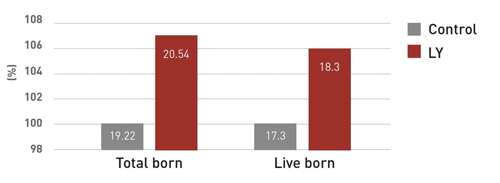
Figure 4. Higher number of piglets were weaned in the LY-group due to lower mortality pre-weaning.
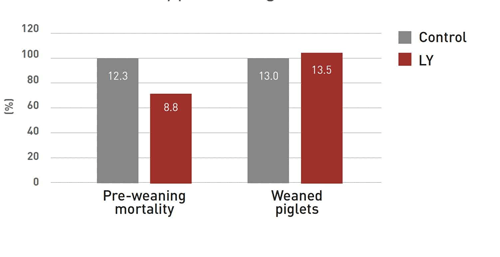
Despite the fact that supplementation of live yeast only started at day 87 of gestation, a higher number of total born piglets was recorded in the LY-group. Individual birth weights were equal between the two groups.
At 24 hours after birth, litters were homogenized by cross fostering. All sows were left with 15 piglets. The pre-weaning mortality in the LY- group was reduced by 28% (12.3% in control group versus 8.8% in yeast supplemented group). This resulted in a higher number of weaned piglets in the LY-group (13.5 vs 13.0 in the CON-group) (figure 4).
In the scope of the recent ban on zinc oxide in piglets’ diets, weaning weights have become crucial to maintain healthy and high performing pigs in following stages. The key objective of this trial, to increase piglets body weight at weaning, was reached: 5.10 kg in the probiotic yeast Sc47 group versus 4.66 kg in control group (figure 5).
These results are in line with previous studies conducted around the world. Improving immune transfer from sows to piglets gives them a good start and the modified intestinal flora of sows helps to develop a healthier and more resilient microbiome in the digestive tract of her offspring.
The higher number of piglets per litter and higher litter weight at weaning suggest that piglets born from sows supplemented with probiotic yeast Sc47 are stronger compared to the control piglets, possibly due to better colostrum and milk quality and quantity. Improving piglet performance pre-weaning resulted in a higher profitability on farm. The return of investment for the use of probiotic yeast Sc47 was 1:10 using the Phileo calculator developed and validated by SIP Consultors.
Figure 5.Piglets weight at 20 days was higher in the LY-group due to higher ADG from birth.
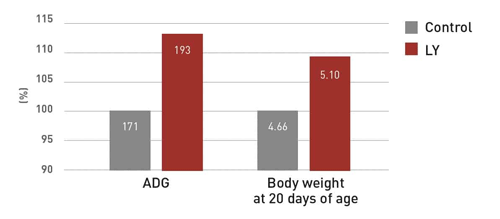
A tested and effective strategy
Raising healthy piglets is a challenge and requires the right nutritional programme for both the sow and the piglets. As the sow has a strong influence on the piglet quality at birth, as well as weaning, it is of high importance to support the sow with the right set of nutrients to boost foetal growth and colostrum and milk quality and quantity among others. This study carried out on a large-scale commercial farm, representative for Spanish pig production, showed that supplementation of Probiotic yeast Actisaf® Sc 47 during gestation and lactation improves the reproductive performance of sows and zootechnical results in piglets.
- +0.5 piglet weaned per litter
- +440 grams bodyweight at weaning
- -3.5% mortality at weaning
- +8.3kg per litter at weaning
These results are in line with other experiences in Europe and beyond. This health through nutrition maternal feeding strategy, supplementing probiotic yeast Sc47, is a proven strategy in in major pig producing countries. It also helps producers with the challenges around weaning to reach the desired piglet weight. Adding probiotic yeast Sc47 to sows diets not only helps to utilize the full genetic potential of the animals, it also aids to reduce dependence on antibiotics and therapeutic zinc oxide, while increasing farm profitability with a strong ROI for pig producers.
Related topics:
Authors:
Phileo by Lesaffre
Recommend
Comment
Share
Recommend
Reply

Would you like to discuss another topic? Create a new post to engage with experts in the community.







